An Improved Ambiguity Resolution Algorithm for Smartphone RTK Positioning
Abstract
1. Introduction
2. Methodology
2.1. GNSS Mixed-Integer Model
2.2. Search-and-Shrink Procedure for Ambiguity Resolution
2.3. Ambiguity Majority Tests for Candidate Ambiguities and Vectors
2.4. Multi-Epoch Residual Test for Ambiguity Validation
3. Static Experiment—Smartphone Ambiguity Resolution Efficiency
4. Kinematic Experiment—Smartphone Positioning Performance
5. Conclusions
- The existence of ambiguity biases is not negligible for AR based on smartphone devices. In the static experiment performed with Xiaomi Mi 8, the average level of ambiguity biases ranges from 0.07 to 0.31 cycles.
- The proposed AR scheme using the search-and-shrink procedure coupled with the majority test and the multi-epoch DD residual test can overcome the problem of AR. The majority test can identify the actual ambiguity vector from the candidates with an accuracy of 71% for the first rank and 6% for the second rank versus 74% and 2% for the DD residual test.
- The proposed method achieves AR to improve the positioning accuracy of smartphones. For the static test, the RMS values are 1.1 cm, 1.7 cm, and 2.1 cm for east, north, and upward directions, in contrast to 0.2 m, 0.2 m, and 0.1 m for the float solutions, respectively. For the kinematic test, the RMS values are 3.8 cm and 3.9 cm for the along-track and the cross-track directions versus 9.8 cm and 8.1 cm for the float solutions.
Author Contributions
Funding
Institutional Review Board Statement
Informed Consent Statement
Data Availability Statement
Acknowledgments
Conflicts of Interest
References
- Banville, S.; Van Diggelen, F. Precise positioning using raw GPS measurements from Android smartphones. GPS World 2016, 27, 43–48. [Google Scholar]
- European Union Agency for the Space Programme. World’s First Dual-Frequency GNSS Smartphone Hits the Market. 2018. Available online: https://www.euspa.europa.eu/newsroom/news/world-s-first-dual-frequency-gnss-smartphone-hits-market (accessed on 15 May 2023).
- Cozzens, T. Qualcomm Launches 3 Dual-Frequency + NavIC Smartphone Modules. GPS WORLD. 2020. Available online: https://www.gpsworld.com/qualcomm-launches-3-dual-frequency-navic-smartphone-modules/ (accessed on 15 May 2023).
- Håkansson, M. Characterization of GNSS observations from a Nexus 9 Android tablet. GPS Solut. 2019, 23, 21. [Google Scholar] [CrossRef]
- Robustelli, U.; Baiocchi, V.; Pugliano, G. Assessment of Dual Frequency GNSS Observations from a Xiaomi Mi 8 Android Smartphone and Positioning Performance Analysis. Electronics 2019, 8, 91. [Google Scholar] [CrossRef]
- Robustelli, U.; Paziewski, J.; Pugliano, G. Observation Quality Assessment and Performance of GNSS Standalone Positioning with Code Pseudoranges of Dual-Frequency Android Smartphones. Sensors 2021, 21, 2125. [Google Scholar] [CrossRef]
- Teunissen, P.; Verhagen, S. GNSS carrier phase ambiguity resolution: Challenges and open problems. In Observing Our Changing Earth; Springer: Berlin/Heidelberg, Germany, 2009; pp. 785–792. [Google Scholar]
- Li, G.; Geng, J. Characteristics of raw multi-GNSS measurement error from Google Android smart devices. GPS Solut. 2019, 23, 90. [Google Scholar] [CrossRef]
- Geng, J.; Li, G. On the feasibility of resolving Android GNSS carrier-phase ambiguities. J. Geod. 2019, 93, 2621–2635. [Google Scholar] [CrossRef]
- Riley, S.; Lentz, W.; Clare, A. On the Path to Precision—Observations with Android GNSS Observables. In Proceedings of the ION GNSS+ 2017, Portland, OR, USA, 25–29 September 2017. [Google Scholar]
- Zangenehnejad, F.; Gao, Y. GNSS smartphones positioning: Advances, challenges, opportunities, and future perspectives. Satell. Navig. 2021, 2, 24. [Google Scholar] [CrossRef] [PubMed]
- Darugna, F.; Wübbena, J.B.; Wübbena, G.; Schmitz, M.; Schön, S.; Warneke, A. Impact of robot antenna calibration on dual-frequency smartphone-based high-accuracy positioning: A case study using the Huawei Mate20X. GPS Solut. 2021, 25, 15. [Google Scholar] [CrossRef]
- Dabove, P.; Di Pietra, V. Towards high accuracy GNSS real-time positioning with smartphones. Adv. Space Res. 2019, 63, 94–102. [Google Scholar] [CrossRef]
- Paziewski, J.; Sieradzki, R.; Baryla, R. Signal characterization and assessment of code GNSS positioning with low-power consumption smartphones. GPS Solut. 2019, 23, 98. [Google Scholar] [CrossRef]
- Gao, R.; Xu, L.; Zhang, B.; Liu, T. Raw GNSS observations from Android smartphones: Characteristics and short-baseline RTK positioning performance. Meas. Sci. Technol. 2021, 32, 084012. [Google Scholar] [CrossRef]
- Wu, Q.; Sun, M.; Zhou, C.; Zhang, P. Precise Point Positioning Using Dual-Frequency GNSS Observations on Smartphone. Sensors 2019, 19, 2189. [Google Scholar] [CrossRef] [PubMed]
- Benvenuto, L.; Cosso, T.; Delzanno, G. An Adaptive Algorithm for Multipath Mitigation in GNSS Positioning with Android Smartphones. Sensors 2022, 22, 5790. [Google Scholar] [CrossRef]
- Wanninger, L.; Heßelbarth, A. GNSS code and carrier phase observations of a Huawei P30 smartphone: Quality assessment and centimeter-accurate positioning. GPS Solut. 2020, 24, 64. [Google Scholar] [CrossRef]
- Heßelbarth, A.; Wanninger, L. Towards centimeter accurate positioning with smartphones. In Proceedings of the 2020 European Navigation Conference (ENC), Dresden, Germany, 23–24 November 2020; IEEE: Piscataway, NJ, USA, 2020; pp. 1–8. [Google Scholar]
- Yong, C.Z.; Odolinski, R.; Zaminpardaz, S.; Moore, M.; Rubinov, E.; Er, J.; Denham, M. Instantaneous, Dual-Frequency, Multi-GNSS Precise RTK Positioning Using Google Pixel 4 and Samsung Galaxy S20 Smartphones for Zero and Short Baselines. Sensors 2021, 21, 8318. [Google Scholar] [CrossRef]
- Teunissen, P.J.G. Success probability of integer GPS ambiguity rounding and bootstrapping. J. Geod. 1998, 72, 606–612. [Google Scholar] [CrossRef]
- Parkins, A. Increasing GNSS RTK availability with a new single-epoch batch partial ambiguity resolution algorithm. GPS Solut. 2011, 15, 391–402. [Google Scholar] [CrossRef]
- Hatch, R. The synergism of GPS code and carrier measurements. In Proceedings of the International Geodetic Symposium on Satellite Doppler Positioning, Las Cruces, NM, USA, 8–12 February 1982; Volume 2, pp. 1213–1231. [Google Scholar]
- Wen, Q.; Geng, J.; Li, G.; Guo, J. Precise point positioning with ambiguity resolution using an external survey-grade antenna enhanced dual-frequency android GNSS data. Measurement 2020, 157, 107634. [Google Scholar] [CrossRef]
- Zeng, S.; Kuang, C.; Yu, W. Evaluation of Real-Time Kinematic Positioning and Deformation Monitoring Using Xiaomi Mi 8 Smartphone. Appl. Sci. 2022, 12, 435. [Google Scholar] [CrossRef]
- Teunissen, P. The least-squares ambiguity decorrelation adjustment: A method for fast GPS integer ambiguity estimation. J. Geod. 1995, 70, 65–82. [Google Scholar] [CrossRef]
- Li, B.; Verhagen, S.; Teunissen, P.J. GNSS integer ambiguity estimation and evaluation: LAMBDA and Ps-LAMBDA. In China Satellite Navigation Conference (CSNC) 2013 Proceedings; Springer: Berlin/Heidelberg, Germany, 2013; pp. 291–301. [Google Scholar]
- Teunissen, P.J.G. Theory of integer equivariant estimation with application to GNSS. J. Geod. 2003, 77, 402–410. [Google Scholar] [CrossRef]
- Odolinski, R.; Teunissen, P.J. Best integer equivariant estimation: Performance analysis using real data collected by low-cost, single-and dual-frequency, multi-GNSS receivers for short-to long-baseline RTK positioning. J. Geod. 2020, 94, 91. [Google Scholar] [CrossRef]
- Odolinski, R.; Teunissen, P.J.G. Best integer equivariant position estimation for multi-GNSS RTK: A multivariate normal and t-distributed performance comparison. J. Geod. 2022, 96, 3. [Google Scholar] [CrossRef]
- Yong, C.Z.; Harima, K.; Rubinov, E.; McClusky, S.; Odolinski, R. Instantaneous Best Integer Equivariant Position Estimation Using Google Pixel 4 Smartphones for Single-and Dual-Frequency, Multi-GNSS Short-Baseline RTK. Sensors 2022, 22, 3772. [Google Scholar] [CrossRef]
- Li, L.; Li, Z.; Yuan, H.; Wang, L.; Hou, Y. Integrity monitoring-based ratio test for GNSS integer ambiguity validation. GPS Solut. 2016, 20, 573–585. [Google Scholar] [CrossRef]
- Khanafseh, S.; Pervan, B. New approach for calculating position domain integrity risk for cycle resolution in carrier phase navigation systems. IEEE Trans. Aerosp. Electron. Syst. 2010, 46, 296–307. [Google Scholar] [CrossRef]
- Verhagen, S.; Li, B.; Geodesy, M. LAMBDA Software Package: Matlab Implementation; Delft University of Technology: Delft, The Netherlands, 2012. [Google Scholar]
- Teunissen, P.J. Integer least-squares theory for the GNSS compass. J. Geod. 2010, 84, 433–447. [Google Scholar] [CrossRef]
- Teunissen, P.J. Least-squares estimation of the integer GPS ambiguities. In Invited Lecture, Section IV Theory and Methodology; IAG General Meeting: Beijing, China, 1993; pp. 1–16. [Google Scholar]
- Chen, D.; Lachapelle, G. A Comparison of the FASF and Least-Squares Search Algorithms for on-the-Fly Ambiguity Resolution. Navigation 1995, 42, 371–390. [Google Scholar] [CrossRef]
- Giorgi, G.; Teunissen, P.; Buist, P. A search and shrink approach for the baseline constrained LAMBDA method: Experimental results. In Proceedings of the International GPS/GNSS Symposium, Tokyo, Japan, 11–14 November 2008. [Google Scholar]
- De Jonge, P.; Tiberius, C. The LAMBDA Method for Integer Ambiguity Estimation: Implementation Aspects; Publications of the Delft Computing Centre, LGR-Series; Delft University of Technology: Delft, The Netherlands, 1996; Volume 12, pp. 1–47. [Google Scholar]
- Chang, X.-W.; Yang, X.; Zhou, T. MLAMBDA: A modified LAMBDA method for integer least-squares estimation. J. Geod. 2005, 79, 552–565. [Google Scholar] [CrossRef]
- Teunissen, P.; Massarweh, L.; Verhagen, S. Vectorial integer bootstrapping: Flexible integer estimation with application to GNSS. J. Geod. 2021, 95, 99. [Google Scholar] [CrossRef]
- Koch, K.-R. Parameter Estimation and Hypothesis Testing in Linear Models; Springer Science & Business Media: Berlin/Heidelberg, Germany, 1999. [Google Scholar]
- Teunissen, P.J. Testing Theory: An Introduction; D. C. Jones: New York, NY, USA, 2009; pp. 123–126. [Google Scholar]
- Baarda, W. A Testing Procedure for Use in Geodetic Networks; Publication on Geodesy, New Series; Rijkscommissie Voor Geodesie: Delft, The Netherlands, 1968; Volume 2. [Google Scholar]
- Chang, G. On kalman filter for linear system with colored measurement noise. J. Geod. 2014, 88, 1163–1170. [Google Scholar] [CrossRef]
- Gao, Y.; Jiang, Y.; Gao, Y.; Huang, G. A linear Kalman filter-based integrity monitoring considering colored measurement noise. GPS Solut. 2021, 25, 59. [Google Scholar] [CrossRef]
- Verhagen, S.; Li, B.; Teunissen, P.J. Ps-LAMBDA: Ambiguity success rate evaluation software for interferometric applications. Comput. Geosci. 2013, 54, 361–376. [Google Scholar] [CrossRef]
- Verhagen, S.; Teunissen, P.J. New global navigation satellite system ambiguity resolution method compared to existing approaches. J. Guid. Control Dyn. 2006, 29, 981–991. [Google Scholar] [CrossRef]
- Takasu, T.; Yasuda, A. Development of the low-cost RTK-GPS receiver with an open source program package RTKLIB. In Proceedings of the International Symposium on GPS/GNSS, International Convention Center, Jeju, Republic of Korea, 4–6 November 2009; Volume 1. [Google Scholar]
- Saastamoinen, J. Atmospheric correction for the troposphere and stratosphere in radio ranging satellites. Use Artif. Satell. Geod. 1972, 15, 247–251. [Google Scholar]
- O’Neill, M.; Ryan, C. Grammatical evolution. IEEE Trans. Evol. Comput. 2001, 5, 349–358. [Google Scholar] [CrossRef]
- Klobuchar, J.A. Ionospheric time-delay algorithm for single-frequency GPS users. IEEE Trans. Aerosp. Electron. Syst. 1987, AES-23, 325–331. [Google Scholar] [CrossRef]
- Goad, C.C. Short distance GPS models. In GPS for Geodesy; Springer: Berlin/Heidelberg, Germany, 1996; pp. 239–262. [Google Scholar]
- Li, B.; Lou, L.; Shen, Y. GNSS elevation-dependent stochastic modeling and its impacts on the statistic testing. J. Surv. Eng. 2016, 142, 04015012. [Google Scholar] [CrossRef]
- Li, B.; Qin, Y.; Liu, T. Geometry-based cycle slip and data gap repair for multi-GNSS and multi-frequency observations. J. Geod. 2019, 93, 399–417. [Google Scholar] [CrossRef]
- Shinghal, G.; Bisnath, S. Conditioning and PPP processing of smartphone GNSS measurements in realistic environments. Satell. Navig. 2021, 2, 10. [Google Scholar] [CrossRef]
- Zhang, X.; Tao, X.; Zhu, F.; Shi, X.; Wang, F. Quality assessment of GNSS observations from an Android N smartphone and positioning performance analysis using time-differenced filtering approach. GPS Solut. 2018, 22, 70. [Google Scholar] [CrossRef]
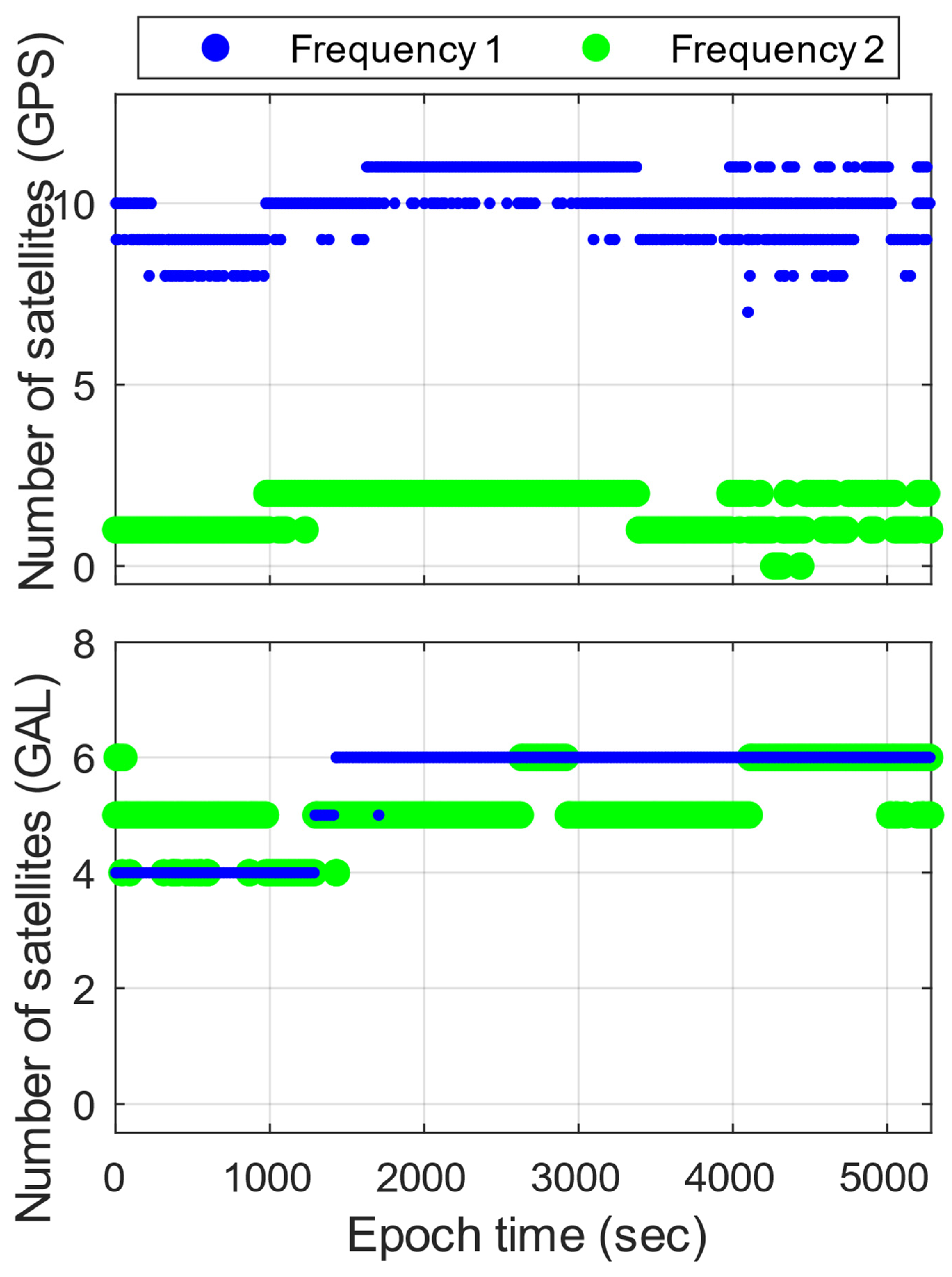
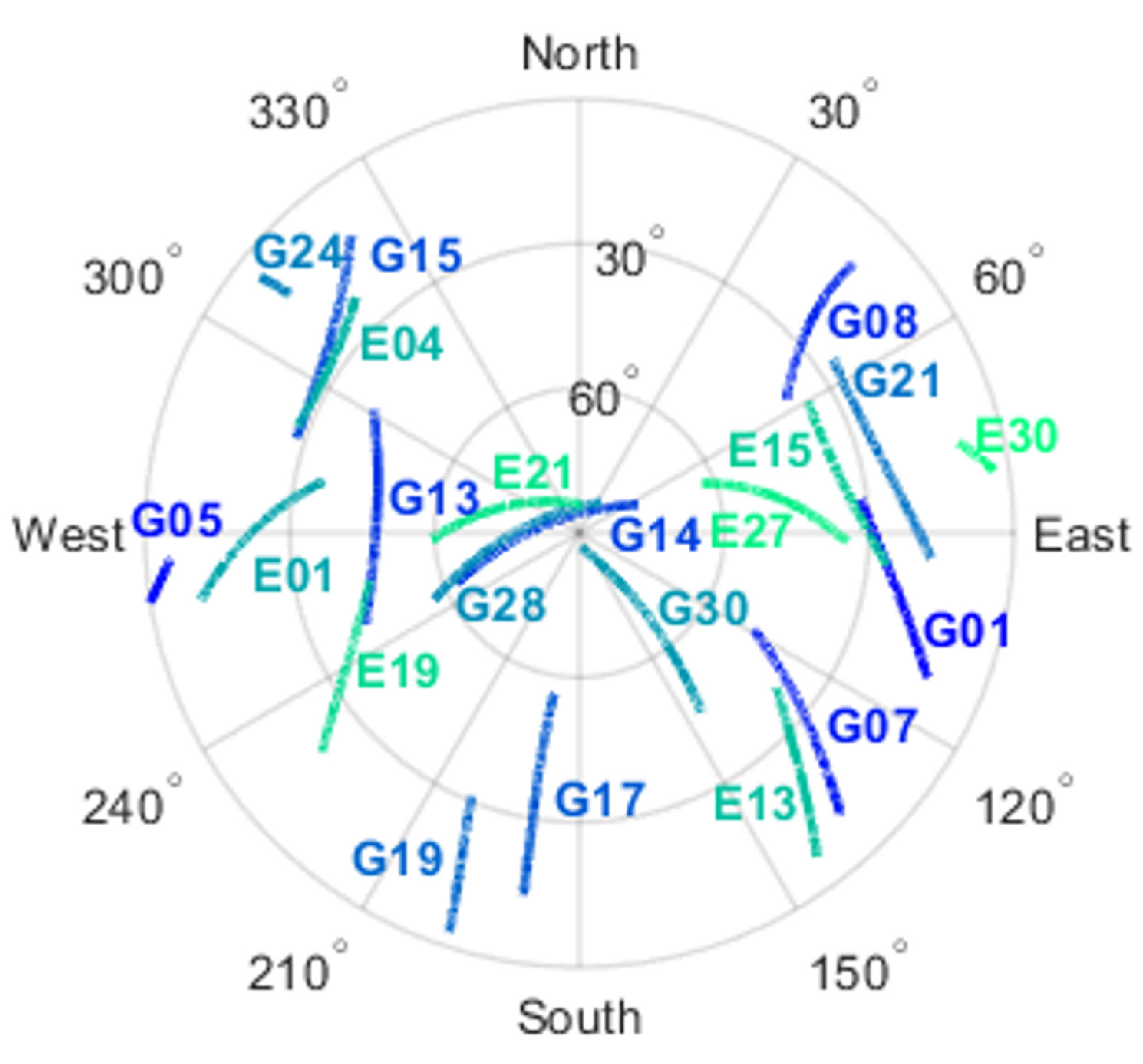


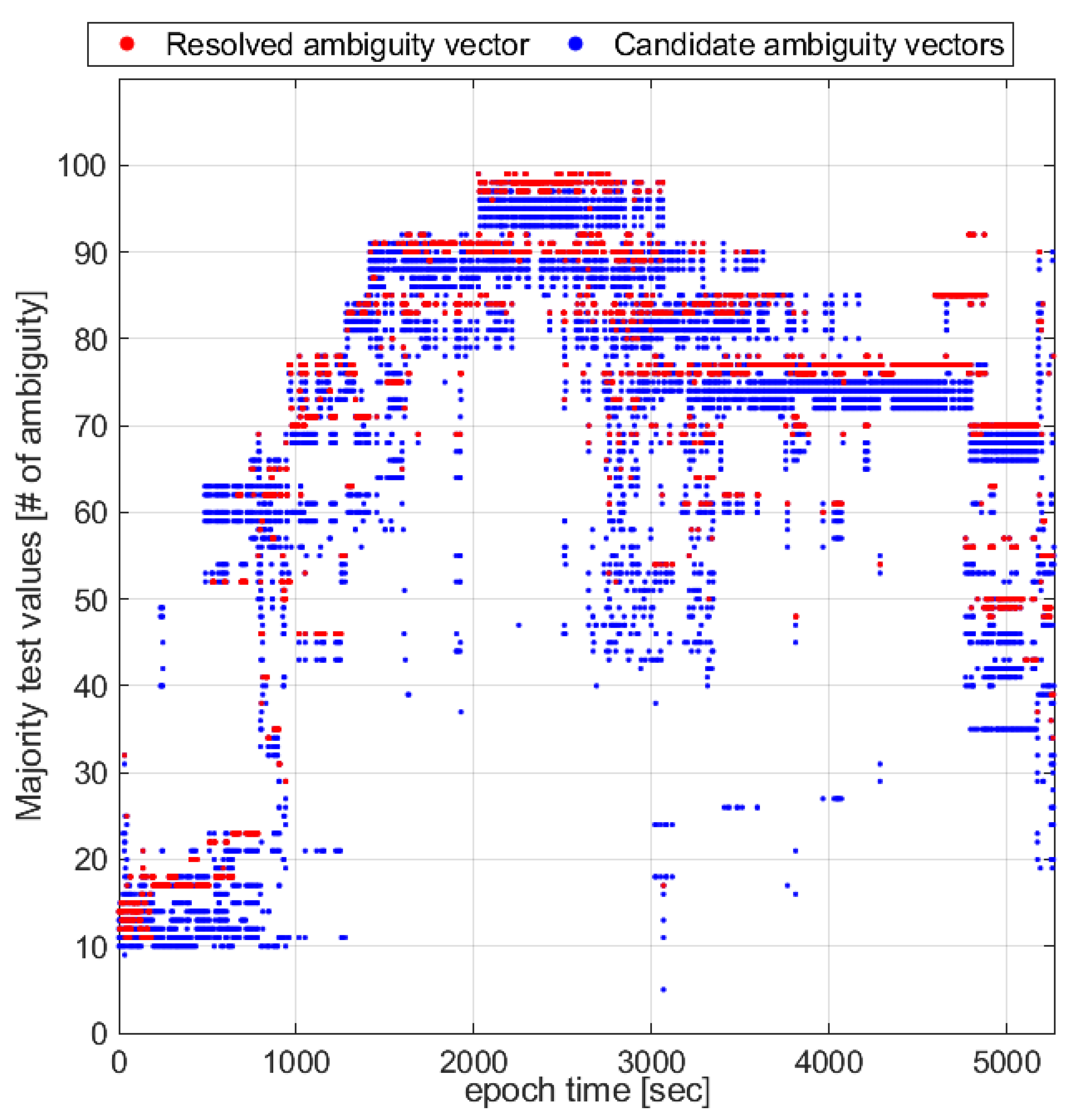
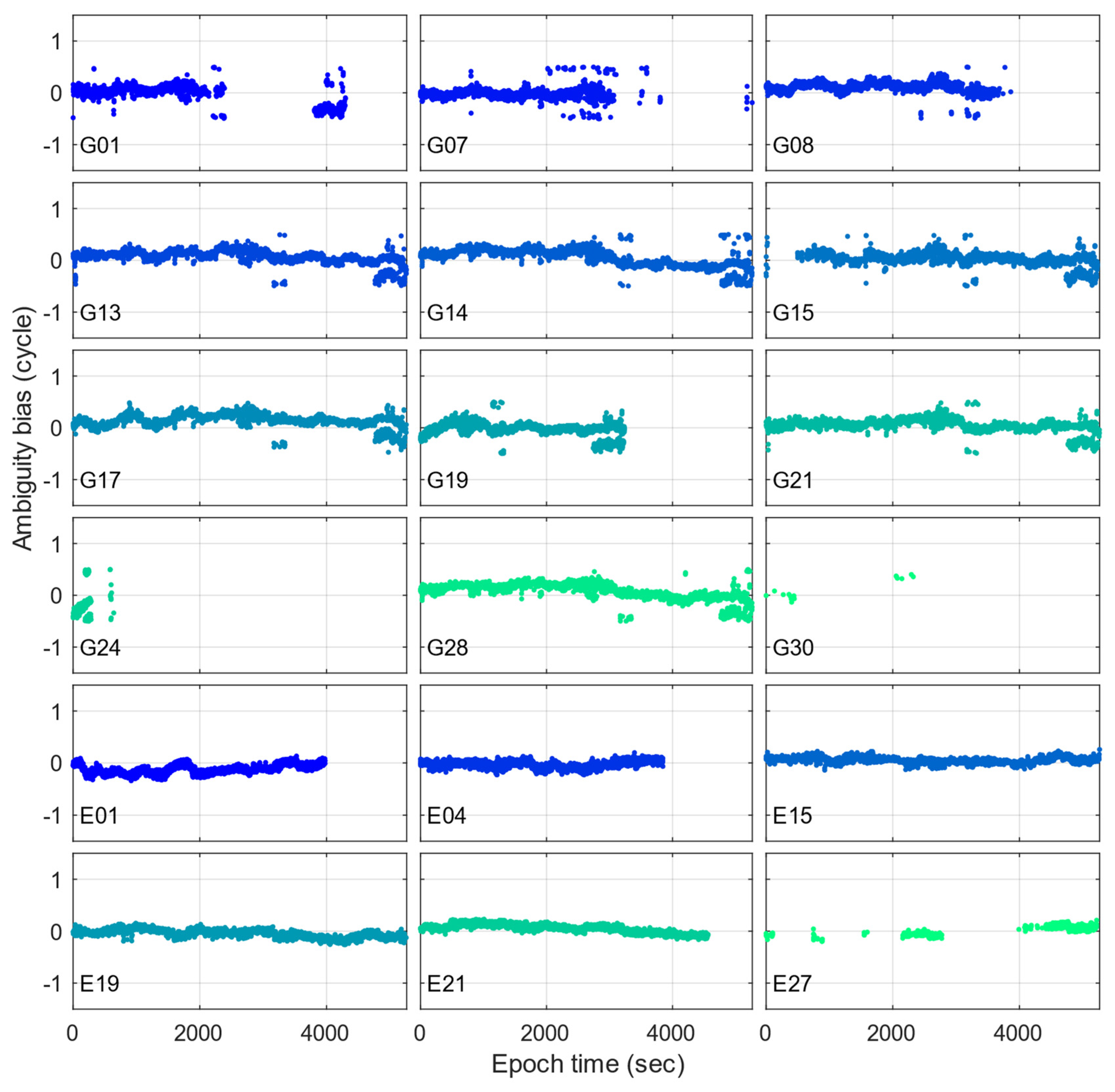
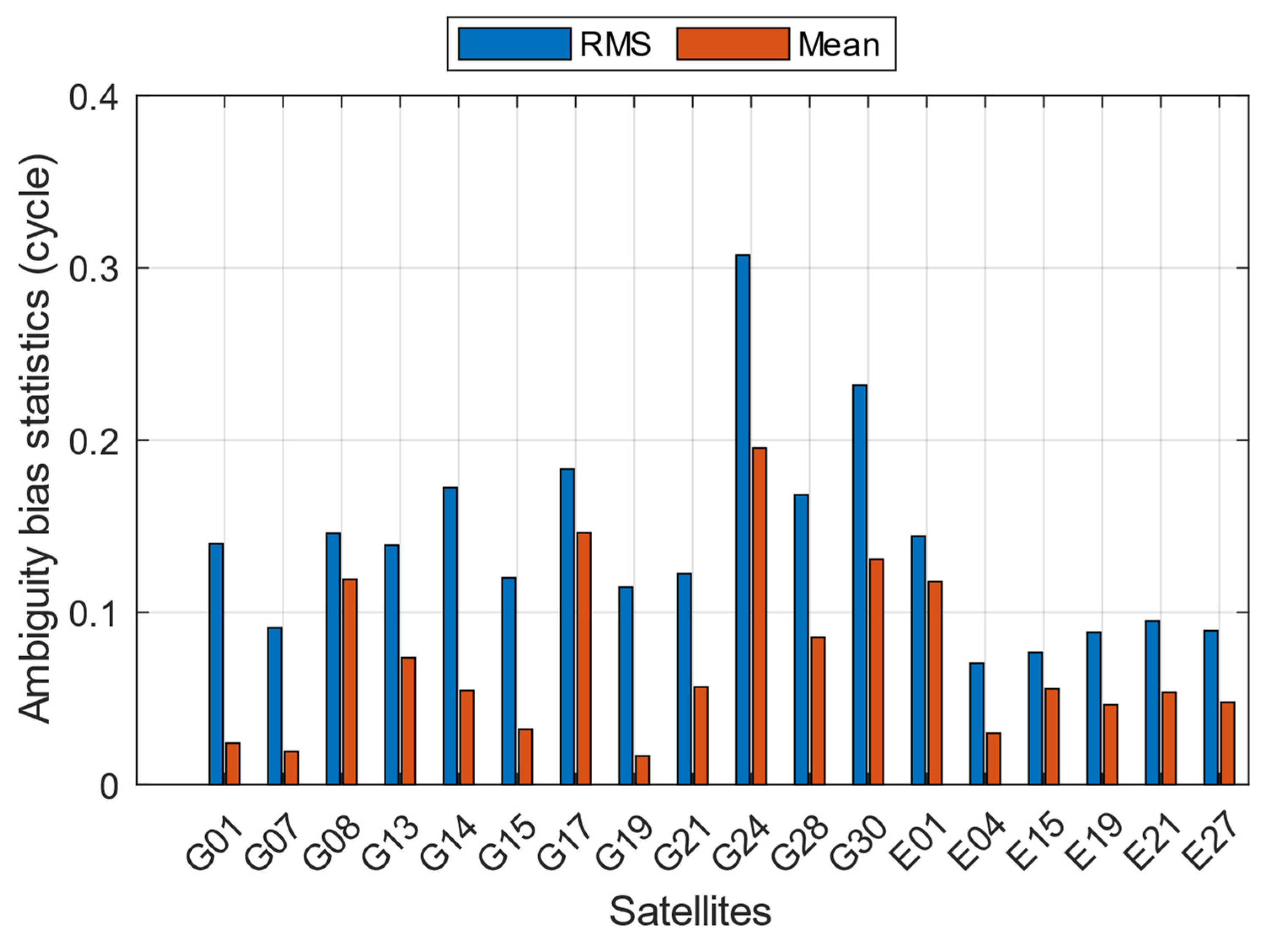


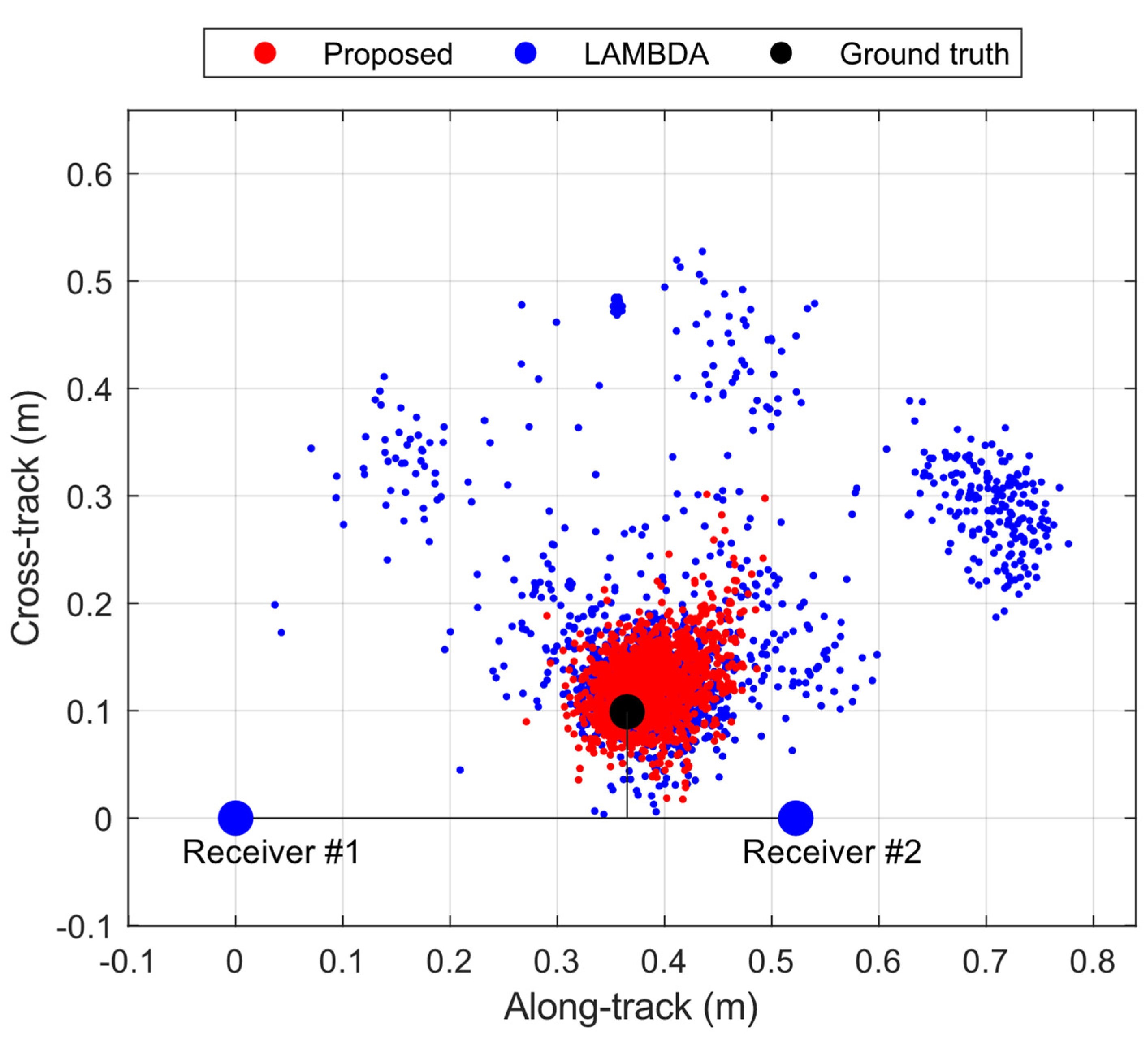

| Parameter Descriptions | Values |
|---|---|
| Number of candidate vectors by LAMBDA | 10 candidates |
| Majority test selection for candidate ambiguity vectors | First 4 candidates |
| Residual test selection for candidate ambiguity vectors | First 4 candidates |
| Residual test window size | 10 epochs |
| Filtering Parameters | Values |
|---|---|
| Stochastic modelling method | Elevation-dependent model [54], , |
| Initial state variance | Coordinates , ambiguities |
| Process noise | Coordinates , ambiguities |
Disclaimer/Publisher’s Note: The statements, opinions and data contained in all publications are solely those of the individual author(s) and contributor(s) and not of MDPI and/or the editor(s). MDPI and/or the editor(s) disclaim responsibility for any injury to people or property resulting from any ideas, methods, instructions or products referred to in the content. |
© 2023 by the authors. Licensee MDPI, Basel, Switzerland. This article is an open access article distributed under the terms and conditions of the Creative Commons Attribution (CC BY) license (https://creativecommons.org/licenses/by/4.0/).
Share and Cite
Jiang, Y.; Gao, Y.; Ding, W.; Liu, F.; Gao, Y. An Improved Ambiguity Resolution Algorithm for Smartphone RTK Positioning. Sensors 2023, 23, 5292. https://doi.org/10.3390/s23115292
Jiang Y, Gao Y, Ding W, Liu F, Gao Y. An Improved Ambiguity Resolution Algorithm for Smartphone RTK Positioning. Sensors. 2023; 23(11):5292. https://doi.org/10.3390/s23115292
Chicago/Turabian StyleJiang, Yang, Yuting Gao, Wei Ding, Fei Liu, and Yang Gao. 2023. "An Improved Ambiguity Resolution Algorithm for Smartphone RTK Positioning" Sensors 23, no. 11: 5292. https://doi.org/10.3390/s23115292
APA StyleJiang, Y., Gao, Y., Ding, W., Liu, F., & Gao, Y. (2023). An Improved Ambiguity Resolution Algorithm for Smartphone RTK Positioning. Sensors, 23(11), 5292. https://doi.org/10.3390/s23115292








